You may have heard that “vertical pulling exercises” like pull-ups and chin-ups are all you need for a strong, wide back.
While these exercises are undeniably effective, they’re only half the story.
To truly maximize your back’s size and strength, you need to include horizontal pulling exercises in your routine, too.
More so than pull-ups and chin-ups, these exercises build your upper and lower back, giving you the overall width and thickness most people strive for.
Which horizontal pull exercises should you do exactly?
Here are my top ten:
- Barbell row
- Seated cable row
- One-arm dumbbell row
- Chest-supported row
- Machine row
- T-bar row
- Seal row
- Meadows row
- Pendlay row
- Barbell rear delt row
In this article, you’ll learn why these rows are my go-to choices, how to do them correctly, why adding them to your program is beneficial, and more.
Want to know exactly how you should train to reach your fitness goals? Take our free 60-second training quiz and find out now.
Table of Contents
+
What Is a Horizontal Pull Exercise?
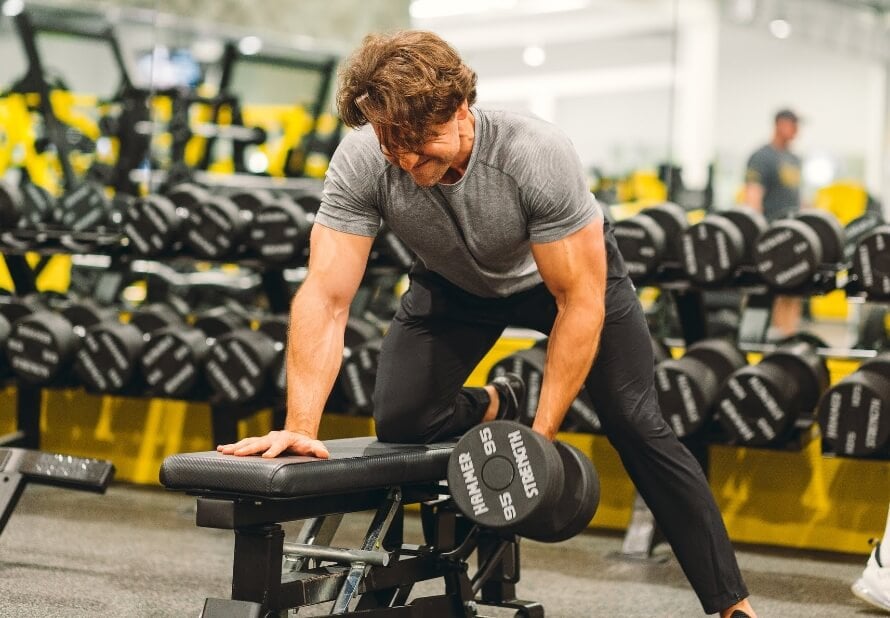
A horizontal pull exercise is any strength training exercise that involves pulling a weight from out in front of you toward your torso. In other words, it’s almost like the opposite of a bench press.
Horizontal pull exercises primarily train four major muscle groups:
- Latissimus dorsi (lats)
- Upper back muscles (rhomboids, traps, rear delts, and teres muscles)
- Lower back muscles
- Biceps
Here’s how these muscles look on your body:
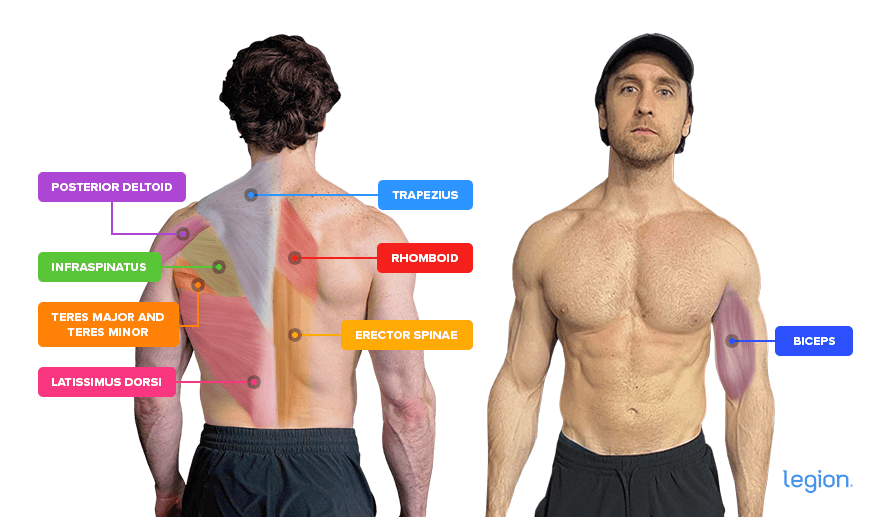
People often refer to horizontal pulls as “rows” because they mimic the movement pattern involved in rowing.
The 10 Best Horizontal Pull Exercises for Back Mass
If you want to build a thick, wide back, make room for some of the following horizontal row exercises in your back routine.
1. Barbell Row
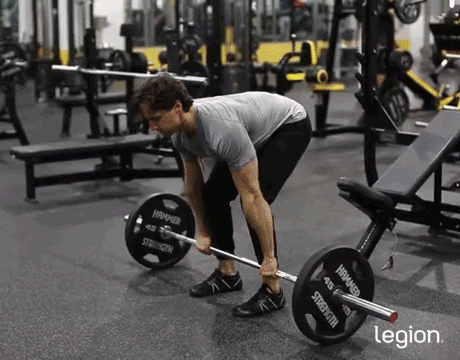
The barbell row is most gymgoers’ go-to horizontal pull exercise because it trains your entire back and allows you to lift more weight than most other row variations, which makes it especially effective for gaining muscle and strength.
How to:
- Position your feet shoulder-width apart under a loaded barbell with your toes pointed slightly outward.
- Bend over and grab the bar with a slightly wider than shoulder-width grip and your palms facing you.
- Straighten your back and raise your hips until your back is roughly parallel to the floor.
- Driving through your legs, then, using the momentum generated by your lower body, squeeze your shoulder blades together and pull the bar to your torso, touching it anywhere between your lower chest and belly button.
- Reverse the movement and return it to the starting position.
2. Seated Cable Row
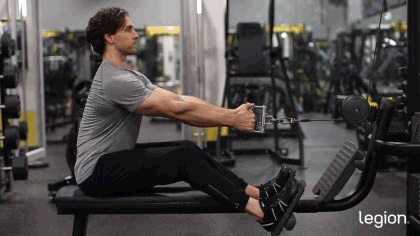
If you’re looking for a lat-focused row, the seated cable row is a solid choice—research shows it’s particularly effective for training your lats.
Because it involves a cable, it also keeps constant tension on your back muscles throughout the range of motion, which trains them slightly differently than other horizontal pull exercises. This is significant because training your muscles in multiple ways leads to more balanced growth than using less variety.
How to:
- Sit on the cable row machine and place your feet on the footrest with your knees slightly bent.
- Lean forward and grab the handle, then lean back with your arms stretched in front of you.
- Straighten your back and pull the handle toward your stomach.
- Once your hands touch your torso, reverse the movement and return to the starting position.
3. One-Arm Dumbbell Row
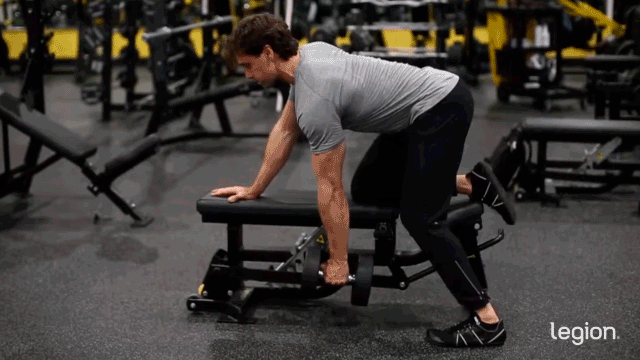
Unlike most horizontal pull exercises, the one-arm dumbbell row trains your mid and upper back unilaterally (one side at a time), making it an excellent row variation for finding and fixing muscle and strength imbalances.
How to:
- Hold a dumbbell in your right hand.
- Plant your left knee and hand firmly on a bench, your right foot on the floor a foot or two from the bench, and let your right arm hang straight toward the floor.
- Keeping your back straight, pull the dumbbell upward until it touches your torso, athen return it to the starting position.
- Once you’ve completed the desired number of reps, repeat the process with your left arm.
4. Chest-Supported Row

The chest-supported row prevents you from using momentum to “cheat” the weight up, which means your back and biceps do all the work. Using a bench also relieves stress on your spine, making the chest-supported row a comfortable horizontal pull exercise for those with back issues.
How to:
- Set an incline bench to roughly a 45-degree angle.
- Grab a dumbbell in each hand and lie prone on the bench with your feet on the floor and your arms extended toward the ground.
- Pull the dumbbells upward until they’re by your sides.
- Reverse the movement and return to the starting position.
5. Machine Row

Of all the different row variations, the machine row is the simplest to learn and perform, which makes it useful in two scenarios. First, it’s an excellent horizontal row exercise for beginner weightlifters who haven’t yet developed the coordination to perform free-weight horizontal pulls proficiently.
And second, since it requires little stabilization, it’s a good option for more advanced weightlifters looking to add extra back volume (sets) to the end of a pull workout when they’re already feeling fatigued.
How to:
- Sit on the machine row seat with your chest against the chest pad.
- Lean forward and grab the handles with your palms facing down.
- Pull the handles toward your body until your hands are by your sides.
- Reverse the movement and return to the starting position.
6. T-Bar Row

Many T-bar row machines or setups allow for a neutral grip (palms facing each other), which can be more comfortable on the wrists and shoulders than horizontal pulls that involve a pronated (palms down) or supinated (palms up) grip. It also makes the T-bar row a more lat-focused row than other exercises on this list.
How to:
- Stand on the T-bar row machine’s footplate facing the weighted end of the bar and with the barbell between your legs.
- While keeping your back flat and knees slightly bent, “hinge” forward until your upper body is at a 30-to-45-degree angle relative to the floor.
- Grab the handle with a neutral grip and lift the bar off the rest.
- Pull the handle toward your body until it touches your torso.
- Reverse the movement and return to the starting position.
7. Seal Row
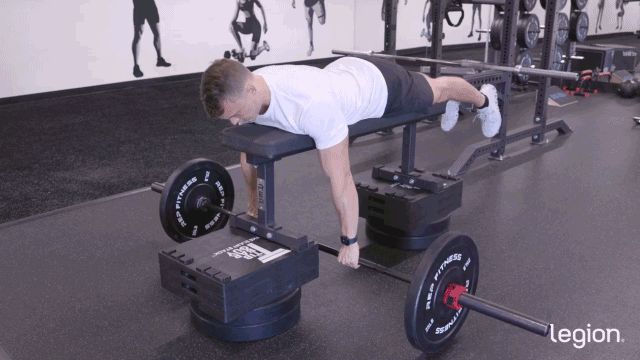
Because you lie prone on a bench during the seal row, you can’t generate momentum with your lower body. This forces your back muscles to do most of the work and ensures you stimulate them sufficiently.
How to:
- Place a loaded barbell under a seal row bench, then lie prone on the bench.
- Grab the bar with a slightly wider than shoulder-width grip and your palms facing toward your feet.
- Pull the barbell toward your upper body until it touches the underside of the bench.
- Reverse the movement and return to the starting position.
8. Meadows Row
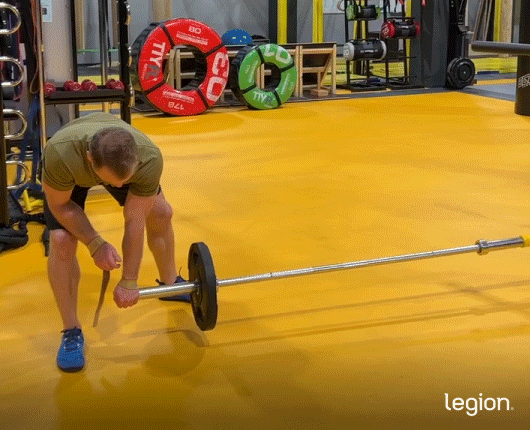
Because the barbell is anchored at one end in the Meadows row, it creates a unique range of motion that trains your lats differently than other horizontal row exercises. The benefit is that it may help stimulate more balanced muscle growth by training the back from angles that other exercises miss.
How to:
- Wedge one end of a barbell into the corner of the room or insert it into a landmine attachment and load the other end with weight.
- Position your right foot perpendicular to the weighted end of the barbell and your left foot 2-to-3 feet behind your right.
- Bend over at the waist until your back is almost parallel with the floor, and grab the end of the barbell with your left hand.
- Pull the bar until your hand touches your torso, then lower it to the starting position.
- Once you’ve completed the desired number of reps, repeat on your right side.
9. Pendlay Row
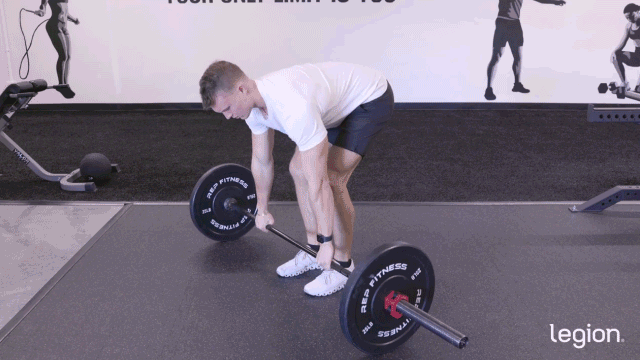
The Pendlay row is a similar horizontal pull exercise to the barbell row, except you don’t use your lower body to help hoist the bar off the floor. By relying solely on your back muscles, you develop explosive power because you need to quickly generate a lot of force to lift the barbell from a dead stop.
How to:
- Position your feet under a loaded barbell about shoulder-width apart, with your toes pointed slightly outward.
- Bend over and grab the bar with a slightly wider than shoulder-width grip with your palms facing toward you.
- Straighten your back and raise your hips until your back is roughly parallel to the floor.
- Pull the barbell to your torso, between your lower chest and navel.
- Reverse the movement and return the bar to the floor.
10. Barbell Rear Delt Row
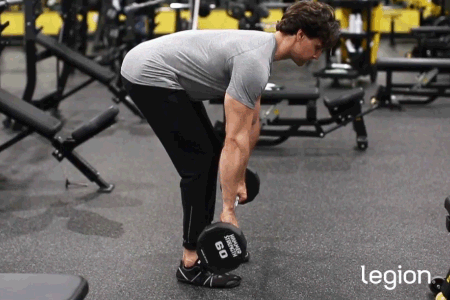
In the rear delt row, you pull the bar to your mid-chest, which is higher than in other horizontal row variations. Doing so reduces the amount your lats contribute to the exercise and makes it more effective for developing your upper back and rear delts.
How to:
- Position your feet under a loaded barbell about shoulder-width apart with your toes pointed slightly outward.
- Bend over and grab the bar with a slightly wider than shoulder-width grip and with your palms facing you.
- Flatten your back so it’s roughly parallel to the floor, and let your arms hang straight down.
- Pull the barbell to your mid-chest, flaring your elbows at about a 60-degree angle relative to your body. Reverse the movement and return to the starting position.
What Are the Benefits of Horizontal Pull ing Exercises?
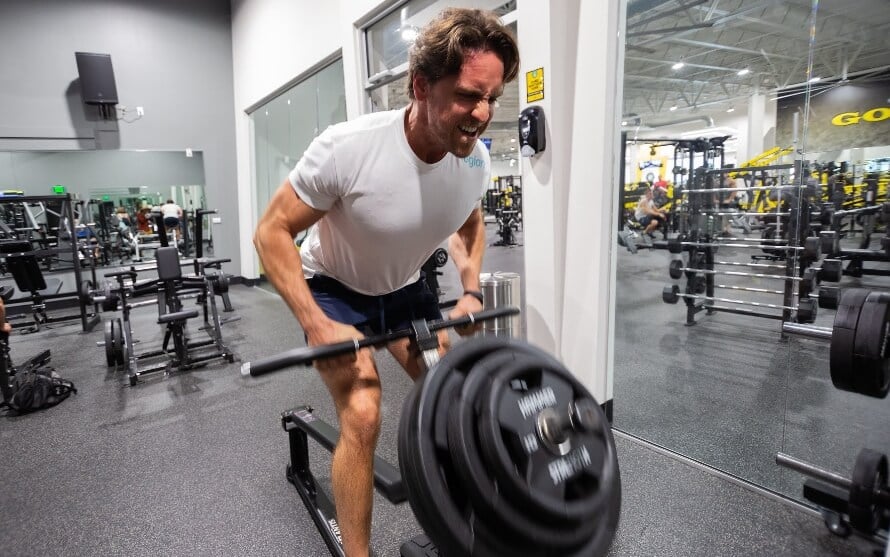
Overall Size and Strength
Many people believe that vertical pulling exercises widen your back by emphasizing your lats, while horizontal pulling exercises build back “thickness” by developing your traps, rhomboids, and teres muscles.
However, this is mostly just gym lore.
Research shows that horizontal pulling exercises train your entire back, including your lats—potentially even more effectively than vertical pulls like pull-ups or lat pulldowns.
In other words, all horizontal back exercises make your back thicker, wider, and stronger.
Improved Posture
Many people with poor posture have weak back muscles. Strengthening them with effective horizontal rowing exercises helps you pull your shoulder blades together and prevent excessive upper back rounding.
Balanced Aesthetics
Many novice weightlifters prioritize the upper body muscles that are visible from the front and neglect back training.
The consequence is that they build big, strong “mirror muscles” that overshadow their weak, underdeveloped back.
Doing horizontal pulling exercises ensures your back muscles gain size and strength at a similar clip to your chest and shoulders, so there’s no weak point in your physique or performance.
Enhanced Athletic Performance
A strong back prevents you from tipping forward in the squat, stops your spine from rounding in the deadlift, and creates a stable base during the bench press.
Thus, strengthening your back muscles with effective horizontal pulls boosts your performance on other exercises.
Develops Functional Strength
Horizontal pulling strength is highly functional because many routine actions rely on it, including opening doors or lifting and moving grocery bags, furniture, and children.
Using rowing exercises to train the muscles involved in these movements helps develop strength that makes day-to-day activities easier.
Supplements to Maximize Gains from Horizontal Pull Exercises
If you want to get the most out of your horizontal pulling, consider these three supplements:
- Protein powder: Protein powder, such as Whey+ (Legion’s whey isolate) or Casein+ (Legion’s micellar casein), provides your body with the nutrients needed to build muscle tissue and recover from workouts.
- Creatine: Creatine boosts muscle and strength gain, improves anaerobic endurance, and reduces muscle damage and soreness from your workouts. For a natural source of creatine, try Legion’s creatine monohydrate, creatine gummies, or post-workout Recharge.
- Pre-workout: A high-quality pre-workout enhances energy, mood, and focus, increases strength and endurance, and reduces fatigue. For a top-tier pre-workout containing clinically effective doses of 6 science-backed ingredients, try Legion’s Pulse with caffeine or without.
(If you’d like even more specific advice about which supplements you should take to reach your health and fitness goals, take the Legion Supplement Finder Quiz, and in less than a minute, you’ll know exactly what supplements are right for you.)
FAQ #1: Can you perform horizontal pull exercises at home?
Yes, but your options are limited without equipment. The best option is the inverted row, which you can perform using the edge of a sturdy table. Here’s what it looks like (using a barbell):
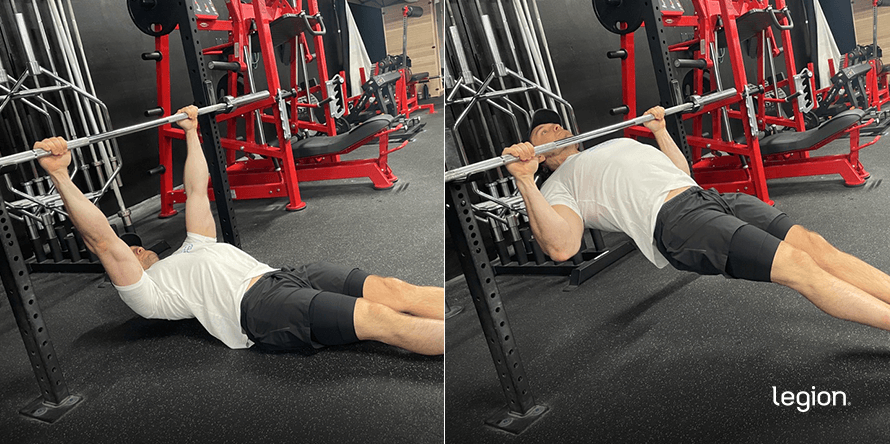
FAQ #2: What are the best horizontal pull exercises with dumbbells?
For most of the barbell exercises above, you can substitute the bar for dumbbells. With that in mind, the best horizontal pull exercises with dumbbells are:
- Dumbbell row
- One-arm dumbbell row
- Chest-supported row
- Dumbbell seal row
- Dumbbell Pendlay row
- Dumbbell rear delt row
FAQ #3: What are the best horizontal pull exercises for beginners?
The best horizontal pull exercises for beginners are:
- One-arm dumbbell row
- Machine row
- T-bar row
Of all the different row variations above, these are the easiest to learn and perform and require the least coordination, which makes them well-suited to those new to strength training.
Scientific References +
- Handa, Tohru , et al. Comparative Electromyographical Investigation of the Biceps Brachii, Latissimus Dorsi, and Trapezius Muscles during Five Pull Exercises. Apr. 2005, pp. 54(2):159-168, http://dx.doi.org/10.7600/jspfsm.54.159.
- Costa, Bruna Daniella de Vasconcelos, et al. “Does Performing Different Resistance Exercises for the Same Muscle Group Induce Non-Homogeneous Hypertrophy?” International Journal of Sports Medicine, vol. 42, no. 09, 13 Jan. 2021, pp. 803–811, https://doi.org/10.1055/a-1308-3674.
- Lehman, Gregory J, et al. “Variations in Muscle Activation Levels during Traditional Latissimus Dorsi Weight Training Exercises: An Experimental Study.” Dynamic Medicine, vol. 3, no. 1, 2004, p. 4, https://doi.org/10.1186/1476-5918-3-4.










